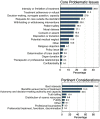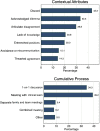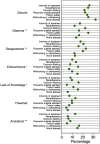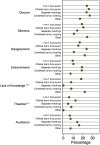Relational, Emotional, and Pragmatic Attributes of Ethics Consultations at a Children's Hospital
- PMID: 33674461
- PMCID: PMC8015157
- DOI: 10.1542/peds.2020-1087
Relational, Emotional, and Pragmatic Attributes of Ethics Consultations at a Children's Hospital
Abstract
Background: Pediatric ethics consultations are important but understudied, with little known about consultations' contextual attributes, which may influence how ethically problematic situations are perceived and addressed.
Methods: We analyzed data regarding 245 pediatric clinical ethics consultations performed between 2013 and 2018 at a large children's hospital. Prespecified data elements included 17 core problematic issues that initiate consultations, 9 ethical considerations identified by the consultation service, and 7 relational, emotional, and pragmatic contextual attributes of the consultation. The main process measure was the cumulative consultation process, ranging from one-on-one discussions with the requestor, to meeting with the clinical team, separate meetings with the patient or family and the clinical team, or combined meeting with the patient or family and the clinical team.
Results: The most-prevalent core problematic issues were intensity or limitation of treatment (38.8%) and treatment adherence and refusal (31%). Common pertinent ethical considerations were best interest (79.2%), benefits versus harms of treatment (51%), and autonomy and decision-making (46.5%). A total of 39.2% of consults culminated with a meeting with the clinical team, 9.4% with separate meetings, and 8.2% with a meeting with all parties. Common contextual attributes were discord (43.3%), acknowledged dilemma (33.5%), and articulate disagreement (29.8%). In exploratory analyses, specific contextual attributes were associated with the core problematic issue that initiated the consultation and with how the consultative process culminated.
Conclusions: Pediatric ethics consultations have contextual attributes that in exploratory analyses are associated with specific types of problems and, to a lesser degree, with the cumulative ethics consultation process.
Copyright © 2021 by the American Academy of Pediatrics.
Conflict of interest statement
POTENTIAL CONFLICT OF INTEREST: The authors have indicated they have no potential conflicts of interest to disclose.
Figures




References
-
- Pediatric Collections . Ethics Rounds: A Casebook in Pediatric Bioethics. Itasca, IL: American Academy of Pediatrics; 2019
-
- Frankel LR, Goldworth A, Rorty MV, Silverman WA. Ethical Dilemmas in Pediatrics: Cases and Commentaries. Cambridge, United Kingdom: Cambridge University Press; 2009
-
- Diekema DS, Mercurio MR, Adam MB. Clinical Ethics in Pediatrics: A Case-Based Textbook. Cambridge, United Kingdom: Cambridge University Press; 2011
-
- Moeller JR, Albanese TH, Garchar K, Aultman JM, Radwany S, Frate D. Functions and outcomes of a clinical medical ethics committee: a review of 100 consults. HEC Forum. 2012;24(2):99–114 - PubMed
Publication types
MeSH terms
Grants and funding
LinkOut - more resources
Full Text Sources
Other Literature Sources
Medical

